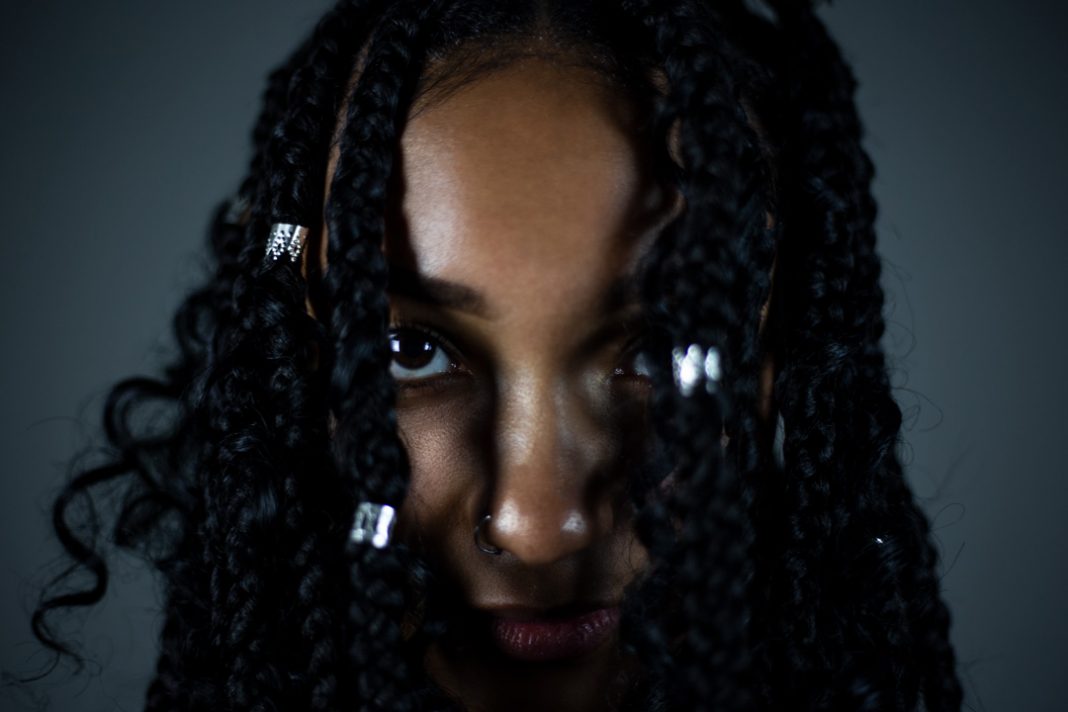Byron Mason: We’re here with Alex Jackson. Artist, very stylish person. Tell me about your outfit from head to toe
Alex Jackson: My shirt is from Forever 21. No tea, no shade. I use Forever 21. My pants--I got on a Black Friday sale at Urban Outfitters. My shoes are from DSW. Nothing special. My hair is styled by Carla Cobb. Knotless box braids. Great stuff
B: How’d you develop your sense of style?
A: I take my wardrobe inspiration from Rico Nasty. She’s my favorite artist of all time honestly. I really bought into her because I feel like women of color, especially black women--we grow up very censored. We’re almost trained to [censor] our bodies because we have all of these amazing features and for some reason, we’re taught to cover up our bodies. That’s how I was raised and I know many other women that were raised that way. I just feel like I wasn’t supposed to be that way. I wouldn’t have been made this way if it wasn’t meant to be shown off in the way that I want to show off my body. I just really took a liking to Rico for her very alternative style. She’s got this trap metal vibe going on that I really like
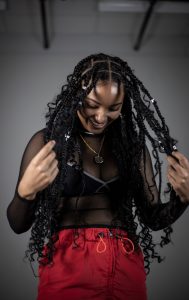
I really enjoy wearing very revealing, tight clothing. Especially clothing that really goes with my tattoos.
My tattoo on my back is a skull with butterflies crawling out of it. On my arm, I have these twin scorpions. And I have a koi fish on the inside. I have these Japanese characters going down my side. It means Natsukashii--it’s most closely translated as nostalgia or the feeling of nostalgia.
B: Going back to what you said about black women growing up, how would you compare your style before coming to Depauw and now?
A: When I was in high school, half of my life was me wearing very regular clothing. I don’t know how else to say it. Nothing was super special about my wardrobe. When I was a senior, I started branching out more. And then when I got to DePauw, I started using my own body in my artwork and therefore, I started paying attention to how I wanted to present myself and how I was most comfortable in my own skin. That’s when I really started developing my own sense of style.
B: Was there a kind of catalyst that made you start to change your style?
A: I consider my tattoos a part of my wardrobe. Me building onto my body in ink is the same as me building onto my body in clothing. So they go hand in hand. The more tattoos I was getting, the more sense of my own custom aesthetic I was getting. And I could more readily pick out outfits that tailor to how I see myself. I don’t know if there’s a direct catalyst other than me growing up and becoming more accustomed to listening to my personal needs and what I want myself to be and how I see myself. Especially [for] my mood. Look good, feel good. I’ve lived by that for so long. I believe that the most important form of self care is working on your self image and how you want to present yourself to the world in whatever way that is.
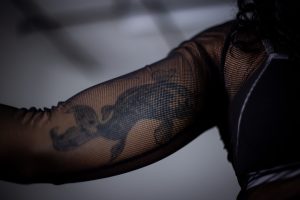
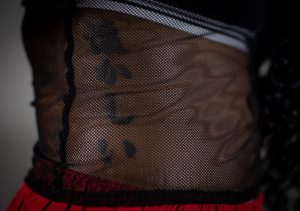
B: With your hair, is that how you express your sense of style too?
A: I’ve definitely been experimenting with my hair lately. I cut off seven inches of my hair before school started last semester in August. I rocked short hair for awhile and then I kind of just got bored of having short hair because it’s still a little too short for me to be putting up. And it was just so convenient that Carla, my roommate, does hair out of our living room. I’ve never had my hair braided before, so that was a leap I took.
B: Going back to your art too. What’s the connection between your artwork and your sense of style?
A: Well most of my artwork is me naked so not that much thought goes into it as far as clothing. But the reason I use my naked body is because my artwork is about the expansive extension of the self. And all of the compartments of our life that have to do with our being and I see my work as intimidating, it’s always in large format, crazy colors. Also, my relationship with color is very sensitive--color is probably ninety percent of my work. I use color for really anything. I can use color for claustrophobia. I can use color for my viewers to feel intimidation or fear.
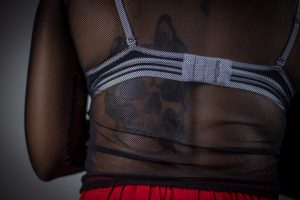
I also like to use space and distorted space as a way of communicating to my audience how many areas that we navigate in our lives that are so accustomed to ourselves. In my work, if I’m not personally in it, it’ll be bathrooms or my bedroom. Just spaces that are very accustomed to me. And it creates this very voyeuristic vibe amongst my audience which I really enjoy. Especially when I feel like, in the art world, my body is a commodity to most people or they feel as though they have a right to certain information about me. And so with that work, I feel like I can control that in a way where I create these very intimidating large prints of very personable aspects of my body or aspects of my life. But it’s from a perspective where you only get a window looking in, but you’re not welcomed into the space. And I do that by distorting rooms or I use mirrors a lot. Or I’ll use color to make a room feel more claustrophobic. I use tile a lot. That’s another distorting factor.
B: You were making this change in your style from high school to college. Was it the same with your artwork? How did you get to the point where you could be so vulnerable and open with your art?
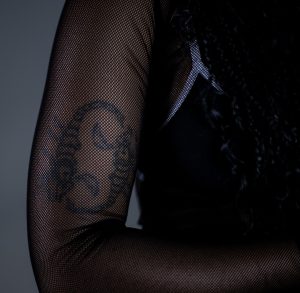
A: It came from my sophomore intro to photography class. Critiques often were uninteresting or boring to me regardless if it was an intro class or not. I wasn’t engaged because I found it hard to want to care about someone trying to pick someone else’s life or experience. I just realized that it’s because people are so afraid to use themselves as subjects. I liked that kind of dangerous, courageous territory. At that point, people really can’t say anything about your art. They can be critical, but they can’t necessarily be critical from the standpoint of content. They can be critical of materialistic things in my work and I’m very open to that as well. But they can’t be critical of content because it’s my own life experience and that’s also a story that will never end. I’ll never run out of things to make work about because my work evolves just as my life does. That’s not only an intimate relationship that I have, but it’s one that people can’t [touch].
Especially being one of the very few black women in Peeler, it’s very difficult to not only explain my art, but defend it as well. I find that it’s more empowering when I use myself because it reminds me of when I was a little kid and everyone is telling me I can’t wear crop tops and I need to put a bra on and all this stuff. So standing up for your little kid self is very important to me and that comes through in my art. It comes through in my clothing--everything.

